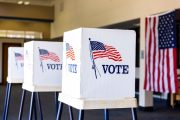
The White House press secretary’s office issued a release on September 17 (Constitution Day) stating that President Obama had launched the “Stand Stronger” Citizenship Awareness Campaign to “encourage eligible immigrants to take an important step in their American journey and commit to citizenship.”
The statement said the campaign “is a project of nonprofit Civic Nation, with assistance from the White House and U.S. Citizenship and Immigration Services.” Civic Nation’s website is scarce on any details about the group’s agenda. Its vaguely worded mission statement says:
Civic Nation is organized to promote sensible solutions to challenges in the areas of federal, state and local policy; to educate the public about such policies and about public policy issues arising in these areas; and, for related purposes.
The press release cited recent estimates that there are approximately 13.3 million “LPRs” (Lawful Permanent Residents) living in the United States, with 8.8 million of them being eligible to apply for citizenship.
To be eligible for citizenship, immigrants must have been legal permanent residents for a minimum of three years, and in most cases five years.
The statement noted that nearly one-third of individuals eligible to apply for citizenship obtained LPR status in 1990 or earlier, and have therefore “been part of our communities for decades. But they don’t yet enjoy all of the rights, benefits, and responsibilities that come with being a full American citizen.”
The release also noted Obama’s controversial November 2014 executive actions (part of which, the use of the Deferred Action for Parents of Americans and Lawful Permanent Residents [DAPA] program to grant amnesty to four million illegal aliens, was put on hold due to an injunction by a federal judge) to establish the White House Task Force on New Americans — “a government-wide effort tasked with enhancing the integration of immigrants and refugees into our communities.”
In April 2015, noted the release, the task force released a “strategic action plan” with the following “set of concrete steps to help promote immigrant and refugee integration by”:
• Strengthening existing pathways to naturalization and promoting civic engagement;
• Building welcoming communities;
• Supporting skill development, fostering entrepreneurship, and safeguarding workers; and
• Expanding opportunities for linguistics integration and education.
A New York Times report, also carried by the Boston Globe, noted:
The officials said they had started the campaign this week because Thursday [in addition to being Constitution Day] is Citizenship Day. But the White House is also aware of federal figures showing that about 60 percent of immigrants eligible to naturalize are Latino and about 20 percent are Asian, both groups that voted overwhelmingly for President Obama. Nearly a third of legal permanent residents eligible to naturalize are Mexican. [Emphasis added.]
The Times report pointed out the obvious: “The campaign, which includes a blitz of television ads with a welcoming message for immigrants, gives Obama a chance to set up a contrast with Republicans vying to succeed him.”
Yet, noted the Times, not all Latino Americans are supportive of the administration’s strategy and offered a statement from Alfonso Aguilar, executive director of the Latino Partnership for Conservative Principles, as an example: “I think it’s healthy for a democracy for people to become citizens,” said Aguilar, “Sadly, I think the administration went overboard. A full-fledged campaign from the White House telling people to become a citizen, I think it is politicizing the naturalization process.”
The Democratic Party’s politicization of the naturalization process has a long tradition in the United States, going back to the Tammany Hall political machine in New York City. Tammany Hall controlled political patronage in Manhattan, starting with the mayoral victory of Fernando Wood in 1854 and built a system based on ward bosses who garnered votes for the party in exchange for bestowing favors on residents of each ward who supported the party line. The machine became very skilled at gaining the support of newly naturalized Irish immigrants. As other immigrant groups came to New York, including Italian and Eastern European Jewish immigrants, Democrat ward bosses were able to enroll most of these newly enfranchised Americans as Democratic voters. Even after the Tammany Hall machine lost influence, more “reform minded” Democrats inherited its groundwork, and the support of immigrant voters was instrumental to reelection of Franklin D. Roosevelt to four terms in office and to the success of Roosevelt’s socialistic “New Deal” programs.
With the passage of time, succeeding generations of middle-class descendants of the massive wave of immigrants who came to this country in the 19th century turned more and more to the Republican Party. The Democratic Party, however, has maintained it dominance among more newly arrived immigrants from Latin America and Asia.
An October 29, 2014, article from the Pew Research Center noted that 57 percent of Latino registered voters supported the Democratic candidate in their congressional district or leaned Democratic, while only 28 percent favored the Republican candidate or leaned Republican — a greater than two-to-one advantage for Democrats. Democrats won the Hispanic vote by a margin of 62 percent to 36 percent in the 2014 mid-term elections.
With statistics such as these being repeated in election after election, it naturally behooves Democratic political organizers to move as many immigrants as possible from the non-citizen, non-voting status to full citizenship.
This is not to say that immigrants who are in this nation legally should not become citizens or want to participate in the political process as part of their responsibilities as new citizens. However, with the privilege of becoming an American citizen come responsibilities — and to divorce those responsibilities from the privilege of citizenship is detrimental to all Americans, whether immigrants or native-born.
One of the most fundamental prerequisites to becoming a citizen who is well informed enough to become an intelligent voter is learning the English language. Compare these two statements in the White House materials:
• Nearly one out of every three eligible individuals obtained LPR status in 1990 or earlier, meaning that many have been part of our communities for decades. But they don’t yet enjoy all of the rights, benefits, and responsibilities that come with being a full American citizen.
And:
• USCIS will expand its in-language materials, currently provided in Spanish, Chinese, and Vietnamese, to include Korean and Tagalog.
Given that most candidates for U.S. citizenship have been in the United States for five years, and that the White House is also reaching out to some immigrants who have been in our country since 1990 or earlier (in other words, more than 25 years) it seems reasonable that such candidates would be fluent enough in English that materials should not have to be made available in Spanish, Chinese, Vietnamese, Korean, and Tagalog (spoken in the Philippines).
Remember: We are not talking about materials instructing newly arrived immigrants on how to qualify for Lawful Permanent Residents status; these materials are for immigrants who have been living in the United States for many years and who expect to be a given a vote in selecting our governmental officials.
If a potential citizen does not have enough interest in the culture and history of the United States to learn the language used by the majority of its citizens and in which all of its official and historic documents such as our Constitution, the Declaration of Indepdence, and the Federalist papers are written, can we reasonably expect that such a candidate for citizenship will vote responsibly?
Perhaps a “no” answer is what the White House has in mind.
We might ask: Which voter would be more likely to elect officials who will consistently violate the Constitution and drive our country to the point of bankruptcy? And which voter would be more likely to read the Constitution, study our history to learn what our Founding Fathers had in mind when establishing our Republic, and vote only for candidates who really mean it when they swear to preserve, protect, and defend the Constitution of the United States? Would it be the voter who made the effort to learn English — or the voter who never made the effort after living amidst English-speaking Americans for five or more years and who requires applications for citizenship translated into his native language?
A better name for the “Stand Stronger Citizenship Awareness Campaign” might be the “Dumbing Down of the American Electorate” campaign.
Related articles:
51 Percent of Immigrant Households Receive Welfare Payments
Census Shows More Immigrants Coming From China, India Than Mexico
Birthright Citizenship Creates Burdensome Economic Consequences
Jeb Bush: Asians Abuse “Noble Concept” of Birthright Citizenship
Government Gives Social Security Numbers to 541,000 Illegals
Cruz Says Obama Administration Is “Counterfeiting Immigration Documents”
Ex-DOJ Official: Obama Using Amnesty to Win Elections for Democrats



